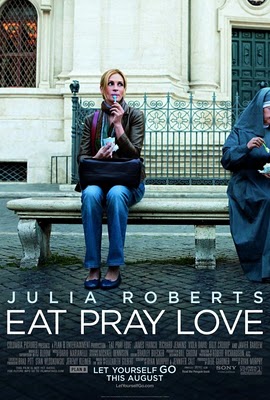
We went and saw Eat Pray Love last weekend. I just had to see it, even though I haven’t read the book yet. (I’ve got it on hold at the library, so it should be coming soon.) I was so curious about this story — a woman’s year-long spiritual memoir, as she travels through Italy, India, and Indonesia. Eat Pray Love. What a great title.
The book, which came out four years ago, is a true phenomenon. It’s #1 on the New York Times bestseller list in paperback nonfiction, and it’s made the list for 180 consecutive weeks. The author, Elizabeth Gilbert, has appeared on Oprah Winfrey telling her story, and of course now it’s a blockbuster movie starring Julia Roberts.
But I went to the movie not knowing much about the book, so I confess it was a little messy and confusing for me — real life is never as neat and tidy as fiction. This movie is a woman’s true story — a very brave woman in my opinion, and I admire her for being a writer willing to share it.
The film opens showing us the glamorous life Julia Roberts/Liz Gilbert is leading: she’s a travel writer based in New York who seemingly has it all: a cute husband who’s crazy about her, a beautiful home, career success with travel assignments around the world. What more could she want?
Yet something is amiss — Liz is unhappy. Although it’s not clear in the movie, she apparently doesn’t want to have a baby. She holds her friend’s baby and asks her, “How did you know you wanted this?” and her friend shows her a box full of little baby clothes that she’s kept for years. Liz then discloses that she’s kept this same type of box … full of magazine clips about travel destinations she longs to visit. She’s confused, and so are we, the movie watchers.
Liz decides to divorce her husband, and this bothered me the whole movie. It was the first time I can remember not sympathizing with a main character. I kept wanting her to wake up and realize she’d made a mistake — but she leaves her old life behind to embark on new adventures. She has a fling with an actor, who’s not quite as tantalizing when they’re in the laundry mat, broke, folding clothes together.
So Liz decides to see the world — these three “I” countries, Italy, India, Indonesia, as she explores her inner “I” and tries to heal from the mess she’s made of her life. Here’s something else that confused me — the movie doesn’t make it clear where she gets the money to do this. There was no scene where Liz approaches her agent or editor and snags a six-figure advance (as she does in real life) to finance her travels. The whole movie I kept wondering, “How does she have enough money to do this?” But in reality, she’s been paid up front to write a book.

So it’s a little similar to the Julie and Julia story and movie, except Julie Powell wrote her year-long blog first, which got picked up by a publisher and turned into a book, then a movie. Gilbert’s book idea was sold before she left, then her travels became a book, which became a movie. OK. See, I’m making this easy for you, so you won’t be as confused as I was.
The film itself is gorgeous. I loved traveling right along with Liz/Julia as she experiences the world far from the madding crowd of New York. (And oh, you’ll want to dive head-first into that Italian pasta!) I looked around the packed theater at people of all sizes and ages, realizing most of us couldn’t afford to travel even for a week to one of these countries. Yet for less than 10 bucks, we’re getting to eat, pray, and love our way through three. Pizza and gelato in Italy, silence and prayer in India, and fresh air and romance in Bali. *sigh.*

There are many reasons for seeing a movie, and here’s one where you’ll spend your money to escape, and that’s OK. For all of us scribblers, the fun part is that Liz is writing the whole time — emails back home, journal entries, tap-tap-tap into her laptop, as she’s forming her thoughts into a book. We can relate to this.
One more confusing thing I’ll clear up: the actress Julia Roberts is 42, although the woman she’s playing was only 31 when she took off on her journey. I think that’s an important point. As I watched the film, I personally felt relieved that I’d gotten most of my traveling out of my system in my early to mid-20s before marriage.
So back to that point I made in the beginning — I couldn’t sympathize with Liz who left her husband because she was unhappy. I kept thinking — why didn’t she and her husband travel together? That seems like more fun to me. When I watched Sandra Bullock in The Blind Side, I sympathized with her the whole movie, as did everybody. Liz is a more complex character, that’s for sure.
If you want to find out more nitty-gritty details about the PG-13 rating, check out the Plugged-In review. I definitely wouldn’t take any of my kids to see it. This is a movie you go see on a girls-night-out, in my opinion. But be prepared — the ending is a surprise for those who haven’t read the book.
Which I plan to do very soon!





